We make decisions every day in our professional lives. Some are mundane and others are consequential to the success of our work. Some decisions we make in a split second and others consume our thoughts for days or even weeks. Some result in great rewards and others leave you solving new problems. Workplace decisions can leave many of us in a position of “analysis paralysis,” unable to make a decision or voice our support for a decision, overwhelmed with all the possible paths and even more possible consequences.
How do we make the “right” decision? How can we make choices quickly and sleep well at night, confident that we’ve made the right one? Is there a way to standardize decision making? Perhaps.
The Original Idea
It was a couple years back while working with a VP on a delicate project that he shared some words of wisdom that have since shaped the way I make most (professional and personal) decisions in my life: “If you don’t balance the triangle of interests, your decision will most certainly have unintended consequences.” I can handle intended consequences or ones I can predict, but those unintended ones always seem to come out of nowhere and knock me off course. Naturally, I wanted to know more about this “triangle.”
The business world is full of triangles—many theories and strategies incorporate them in some way, typically to illustrate factors that constrain an outcome. But the triangle my colleague referred to was what he called the Company-Client-Contributor triangle. The concept is that each point of the decision triangle is held up by the interests of the Company, the Client, or the Contributor—all weighted equally and contributing to the success of the decision and any potential results. (Note: A contributor in this context is anyone working on behalf of the company to fulfill a client’s needs. This might be a third-party but it’s more likely to be an employee of the Company. The contributor has interests that may be separate or even conflict with the company and client. Since the contributor is likely to focus on their interests as they perform the work, those interests need to be considered.)
Here’s a visual of the original triangle
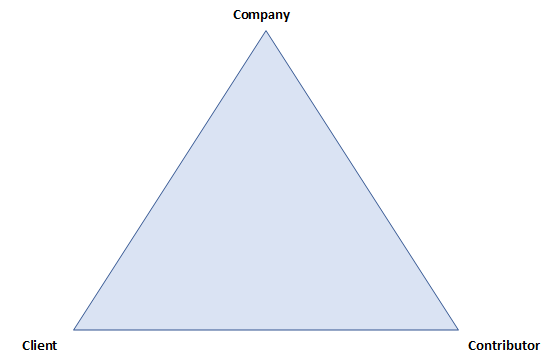
Important Note: The company, client, and contributor are all equally weighted and can be placed at any of the three points of the triangle, the one at the top is NOT there to convey increased importance.
Thanks to that original inspiration and my own “nerdy” ways, I have taken this concept quite a bit further.
Identifying Interests
The first step in balancing this triangle is to identify the interests of the three points of the triangle. There are some broad interest categories to consider, and within those categories it’s important to drill down to the interests related to the decision being made.
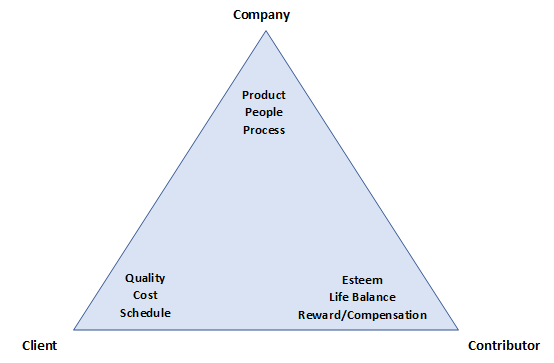
Let’s talk a little more about what these interest categories mean—no doubt you have more to add to this conversation than I have included here.
Company: A company’s broad interests should be Product, People, and Process. Those three interests allow for revenue and profits when deployed correctly.
- Product: A company is interested in the integrity of the product and how it’s used and perceived in the marketplace.
- People: A company is interested in the skills of its people, how the people work with colleagues and service clients, and the overall satisfaction of the people they employ.
- Process: A company is interested in a consistent, scalable process that can support all clients in a way that allows for repeatable success and efficient use of resources.
Client: A client’s broad interests typically focus on Quality, Cost, and Schedule of a product or service.
- Quality: A client is interested in receiving a product of high-quality that meets their expectations and can be used as they intend.
- Cost: A client is interested in spending less than or equal to their budget or quote for the intended product or service.
- Schedule: A client is interested in receiving the product or service in time to meet their needs.
Contributor: A contributor’s broad interests usually involve Esteem, Life Balance, and Reward/Compensation.
- Esteem: A contributor is interested in job tasks and processes that result in positive feelings related to their participation/performance, the perception of them by others, and the satisfaction of the client.
- Life Balance: A contributor is interested in maintaining a healthy work/life balance.
- Reward/Compensation: A contributor is interested in being compensated (financially or otherwise) for the work they perform, including additional recognition in times of going above and beyond expectations.
Applying the Triangle
Now that we’ve laid the foundation for this approach, let’s work through some examples. (These are real-world examples with some information changed to avoid identifying the company or product involved.)
Example 1: Which pricing do we offer?
Company ABC goes to market with the same products in two different methods. Method 1 is as individual components sold via website sales supported by a category manager paid 3% commission on sales made in their category. Method 2 is as replacements for components in a program sold via in-person sales supported by dedicated sales representatives making 6% commission. The sell prices of the components are different depending on the method to account for the different commission rates and value-added when used in the program. To unpack that a bit for you, think of a roll of string sold as a normal roll of string in Method 1 and as a roll of string to create a specific craft in Method 2.
Clients that use the items as part of a bigger program rarely use the website to order and instead go right to their sales representative. However, one of those clients has emailed into the general customer service inbox and received a quote using Method 1 pricing, which is lower than they typically pay. The client is understandably confused and concerned, so they send the quote to their sales representative. Upon learning of the situation, the sales representative is concerned about their relationship with this client and the potential impact on their sales commission.
This is what the triangle looks like for this example:
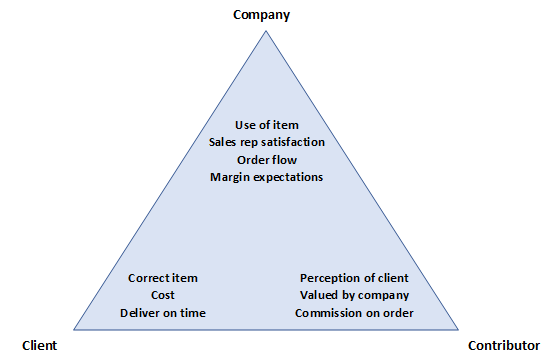
The sales representative wants to get commission for the order from “their” customer and wants to be able to honor the pricing submitted to the client (replacing the quote with a higher priced one will negatively affect the client’s perception of the rep and likely the company). They also don’t want the category manager to see any commission on something they didn’t do work for but that’s just “noise”—we consider a factor to be “noise” when it is valid but not something to consider in solving the actual issue.
The client wants to make sure the items they receive will work with their program materials, and they want the lowest price possible.
The company wants to account for the value-add of the item provided—there is added value to the client in providing an item guaranteed to work with their program materials. The company also wants to keep the sales representative happy, maintain margin expectations on the order (not overpay commissions), and have an order flow that works best for all clients.
So, what would you do? How would you solve this example? (See the real-world decision to this example later in this blog.)
Example 2: How do we prioritize?
Company 123 makes widgets of various sizes for clients. Client A’s order is 75% complete and on track to be done tomorrow but isn’t due for three days. The company receives a call from Client B that the order they just received was created with the wrong tolerance levels and needs to be redone immediately. They needed the order by yesterday when it arrived but because of some other delays unrelated to Company 123, they can take delivery no later than five days from now. The work will take two days to complete and deliver. Company 123 does not have the capacity to complete the work for Clients A and B at the same time.
Here’s the triangle, with Client B’s interests represented:
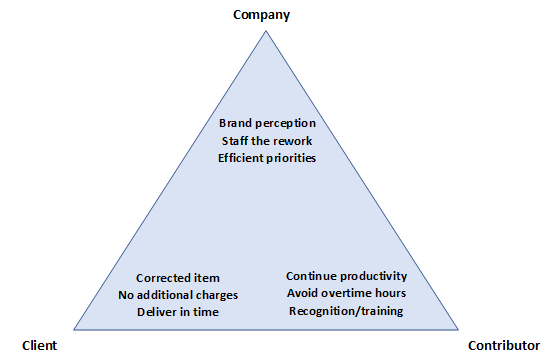
The client wants the correct item, to their specified tolerance, at no additional charge within the next five days.
The company wants to improve the brand perception with a quick turnaround on the replacement items. They want to use the best-trained staff and prioritize the two competing priorities efficiently.
The production associate leading the team wants to finish the existing Client A order before informing the team of the need to redo Client B’s order. They’re concerned about losing productivity on Client A’s order due to a drop in morale or the change in order details. It’s important to avoid overtime hours so the team can maintain work/life balance. The lead wants to be sure the team gets necessary retraining and then recognition for redoing Client B’s order quickly.
So, what would you do? How would you solve this example? (See the real-world decision to this example below.)
Example 3: Who do we assign?
A vendor receives a new project request, and the author team has asked for a specific project manager based on previous experience working together. The project manager is in high demand and has a full workload. The vendor has a newer project manager who shows great promise at being able to meet the same level of service as the requested project manager.
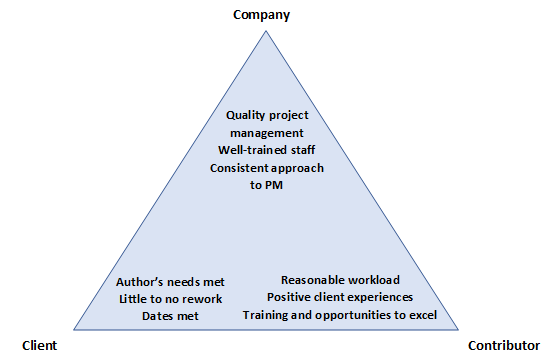
The contributor point of the triangle represents both the requested project manager and the newer project manager. Each wants a reasonable workload, positive client experiences (it is a wonderful feeling when you are asked for specifically!), and proper training with opportunities to excel.
The client wants to be sure this author team is well taken care of—that their needs are met as well or better than in the previous project. The client also wants to avoid the frustration and possible expenses of rework that can sometimes come when a new contributor is assigned.
The company wants to maintain their reputation for quality project management and train their staff well to provide a consistent project management approach.
So, what would you do? Who would receive the assignment? (See the real-world decision to this example below.)
Real-world decisions
In Example 1, Company ABC honored the Method 1 pricing, paid commission to the Sales Rep and the Category Manager on this one order (taking a small margin hit), and created a task force to use Six Sigma practices to improve the pricing and sales processes while meeting all the business requirements of both go-to-market strategies. There is now only one sell price for each item sold, regardless of use, and that sell price accounts for the highest commission rate.
In Example 2, Company 123 paused production of Client A’s order at the end of the day, began the next day with a 1-hour re-training session for the production team and then began working on Client B’s replacement order. The replacement order delivered on time and Client A’s order ended up delivering a half-day late due to transitions between the workflows. Client A did not complain, but that was a concern when the decision was made.
In Example 3, the vendor assigned both project managers to the project. The newer project manager would take lead, with guidance, training input, and overall support from the requested project manager. They would work closely together on the account, hosting weekly meetings to be sure the work was performed to the same quality as the previous project.
Would you have done things differently? What other interests would have factored into this decision-making triangle for you? With these examples, it’s easy to see how, by balancing the interests of all members in the triangle, the best outcome was achieved.
Closing Thoughts
While “balancing the triangle” in various scenarios in recent years I’ve developed a method to applying this technique that works for me—my mind automatically thinks through the interests in a specific order and then to possible consequences if each interest isn’t honored. I intentionally don’t share that with you here—your natural method and sequence likely won’t match mine and that’s how it should be. For this concept to become such a normal part of your thought process, it needs to be one that comes naturally to YOU.
I do, however, encourage you keep in mind the following tips:
- Write it out. At least in the beginning, draw the triangle to help you think it through.
- Certain pieces will feel heavier than others and will guide your thinking. Let them.
- Ignore the “noise.” Some of the factors that feel important may be important to things like company culture, morale, interpersonal communications, process improvements, etc., but that doesn’t mean they are important to the decision at hand. Separate them and handle both as appropriate.
- There is rarely a “right choice” because it’s almost impossible to have ALL the information necessary to make a “right” choice. But there is usually a “best choice” based on the information you do have, and that is (clichéd, I know) the best you can do.
- Don’t be afraid to pivot. If it becomes clear the decision made could be improved or changed (likely based on new information), then make a new decision. I recommend revisiting the triangle with the new information to double-check yourself.
- Avoid making decisions on your own. If there are other departments involved in a consequence of your decision, let them share in the decision making. If your team will be executing your decision, include them in the decision making. You will find more interests fill up that triangle and a better “best” decision can be made.
What are your thoughts on the client-contributor-company triangle? What’s your experience in balancing multiple priorities and interests in decision making? We want to hear from you! Email the Lumina team to share your thoughts or request a downloadable version of the Company-Client-Contributor triangle to practice on your own! Or visit our website to learn more about Lumina Datamatics.
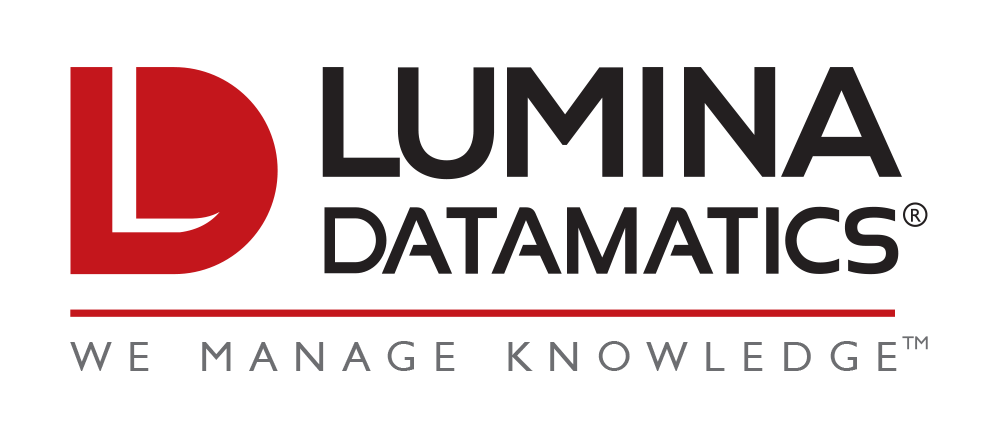




0 Comments